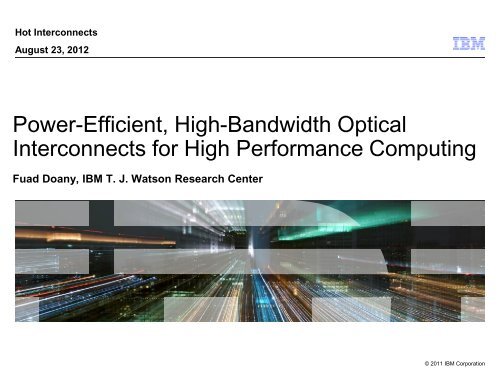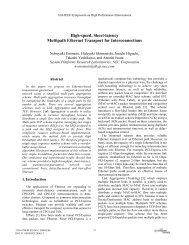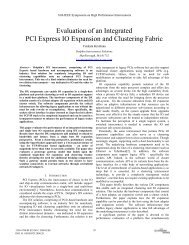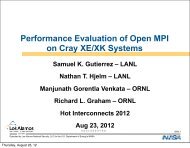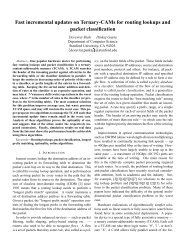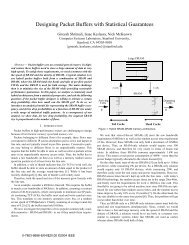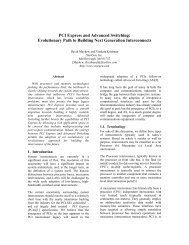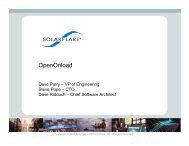Power-Efficient, High-Bandwidth Optical ... - Hot Interconnects
Power-Efficient, High-Bandwidth Optical ... - Hot Interconnects
Power-Efficient, High-Bandwidth Optical ... - Hot Interconnects
Create successful ePaper yourself
Turn your PDF publications into a flip-book with our unique Google optimized e-Paper software.
<strong>Hot</strong> <strong>Interconnects</strong>August 23, 2012<strong>Power</strong>-<strong>Efficient</strong>, <strong>High</strong>-<strong>Bandwidth</strong> <strong>Optical</strong><strong>Interconnects</strong> for <strong>High</strong> Performance ComputingFuad Doany, IBM T. J. Watson Research Center© 2011 IBM Corporation
Acknowledgements & Disclaimer• IBM Colleagues– C.Schow, F. Libsch, A. Rylyakov, B. Lee, D. Kuchta, P. Pepeljugoski, C. Baks, C.Jahnes, R. Budd, J. Proesel, J. Kash, Y. Kwark, C. Tsang, J. Knickerbocker, Y. Vlasov,S. Assefa, W. Green, B. Offrein, R. Dangel, F. Horst, S. Nakagawa, Y. Taira, Y.Katayama, A. Benner, D. Stigliani, C. DeCusatis, H. Bagheri, K. Akasofu, B. Offrein, R.Dangel, S. Nakagawa, M. Taubenblatt, M. Soyuer and many others…• Emcore Corporation– N.Y. Li, K. Jackson• Endicott <strong>Interconnects</strong>– B. Chan, H. Lin, C. Carver• IBM’s Terabus project partially supported by DARPA under the Chip to Chip <strong>Optical</strong>Interconnect (C2OI) ProgramThe opinions expressed in this presentation are those of the Author and do notnecessarily represent the position of any Government funding agencies.2© 2011 IBM
Evolution of <strong>Optical</strong> interconnectsTime of Commercial Deployment (Copper Displacement):1980’s 1990’s 2000’s > 2012WAN, MANmetro,long-haulTelecomLANcampus, enterpriseDatacomSystemintra/inter-rackBoardmodule-moduleModulechip-chipICon-chip• BW*distance advantage ofoptics compared to copperleading to widespreaddeployment at ever-shorterdistances• As distances go down thenumber of links goes upputting pressure on powerefficiency, density and costComputercomIncreasing integration of Optics withdecreasing cost, decreasing power, increasing density© 2011 IBM
Outline• Brief Intro to Fiber Optics Links• Fiber Optics in HPC– Evolution of optical interconnects in HPC systems– System needs and power, cost and density challenges• Path to Optimizing power and efficiency– Packaging Integration– <strong>Optical</strong>-PCB Technology– Chip-scale Integration: Generations of Parallel VCSEL Transceivers– <strong>Optical</strong> Link Improvements– New Technologies: Si Photonics, Multicore Fiber, CWDM• Pushing the Limits of Speed and <strong>Power</strong>– Equalization for improved speed and margin– Fast SiGe circuits to probe VCSEL speed limits• Concluding Comments4© 2011 IBM
LasersLasersLasersDetectorsLasersLasersDetectorsTwo Fiber Optics Camps: Telecom Telecom and Datacom/Computercomor Datacom?• Telecom links (10’s – 1000’s of km)TELECOM–Expensive to install fiber over long DWDM distances = Dense WDM = Wavelength Division Division Multiplexing TELECOMM–Wavelength Division Multiplexing (WDM) Data stream partitioned Single into optical 4 parallel channel wavelength• Maximize use of installed fiber–Performance is primary objective–Component cost secondaryTelecom or Datacom?• Fiber amplifiers, dispersion compensatorsFiber• EML’s, external modulators, APD receivers… TELECOMDWDM = Dense Wavelength Division Multiplexing–Reliability and long operating life is critical• Datacom/Computercom links (100’s of meters,Fiberor less)TDM = Time Division Multiplexing–Cost is the biggest factorSingle optical channel,Laser–Transceivers are commodities Electronic Mux/Demuxing• Multimode fiber & optics (relaxed mechanicaltolerances)• VCSELs, pin receiversTelecom or DatacomDWDMPassive data= Dense Wavelength Doptical carried Mux/Demuxingon separate ’sMUXDetectorData stream partitioned into 4 paralPassive DEMUXoptical Mux/DData stream partitioned into 4 parallel wavelength channelsPassive optical Mux/DemuxingMUXDEMUXTDM = Time Division MultiplexingDATACOMSingle optical channel,Electronic Mux/DemuxingTDM = Time Division MultiplexingSingle Laseroptical channel, FiberElectronic Mux/Demuxing–Reliability (was) less of an issue: pluggablemodulesLaser Fiber Detector–Reach typically not an issueDATACOMFiberSDM = Space DivisionMultiplexingMUXParallel fiber channels,No Mux/DemuxingFiberDDATACOSMSDM = SpacMultiplexingDetectorPaNoTerabus© 2011 IBM
What does an optics link consist of?CPU or Switch chipSerializer,Coding, & ClockEDatacom/Computercom:Vertical Cavity SurfaceEmitting Laser (VCSEL)PrePredriverAmp _TX OE ModuleLaserDriverIII-VLaserV b1O<strong>Optical</strong> fiber and/or waveguides,optical connectors…V b2PD_TIARX OE ModuleLA50WDriverECPU, Switch chipDeserializer,Decoding &CDR~6umGaAs5-10mmSEM top view• Low <strong>Power</strong> Devices: low-threshold, direct hi-speedmodulation• Cost: much cheaper than edge-emitting lasers– Wafer-scale fab and test• <strong>High</strong> Density– 2-D arrays possible• Temperature control– ~ 40 °C for VCSEL vs. 1 °C for DFB lasers & AWGs– No thermoelectric coolers, low power consumptionToday, VCSELs dominate the Datacom/Computer <strong>Interconnects</strong>: Millions/month ShippingDatacom VCSELs cost
Outline• Intro to Fiber Optics Links• Fiber Optics in HPC– Evolution of optical interconnects in HPC systems– System needs and power, cost and density challenges• Path to Optimizing power and efficiency– Packaging Integration– <strong>Optical</strong>-PCB Technology– Chip-scale Integration: Generations of Parallel VCSEL Transceivers– <strong>Optical</strong> Link Improvements– New Technologies: Si Photonics, Multicore Fiber, CWDM• Pushing the Limits of Speed and <strong>Power</strong>– Equalization for improved speed and margin– Fast SiGe circuits to probe VCSEL speed limits• Concluding Comments7© 2011 IBM
Maintaining the HPC Performance Trend#1 machine:IBM BG/Q16PFchart data from www.top500.org10x /3.5-4yrs10PF 2012 1EF 2020All other55.4%44.6%Performance enabled by increased parallelism:• Processor speed no longer primary driver• Aggregation of massive numbers of multicore processors• Challenging interconnect BW demands across system hierarchy• Intra-chip, inter-chip, on-board, intra-rack, between racks• Communication bottlenecks moving closer to processors• Optics displacing copper at ever shorter distance scales© 2011 IBM
Evolution of Parallel Optics in Supercomputers2002: NEC Earth Simulator• no opticsSnap 12 optical module12 Tx or Rx at 2.5Gb/sCombination of Electrical& <strong>Optical</strong> Cabling2005:IBMASCI PurpleServer (LLNL)100 TeraFLOP/s~3000 parallel links12+12 @ 2.5Gb/s/chOptics for >20m links9© 2011 IBM
Percentage of Links (%)2008: PetaFlop ComputersLANL RoadRunner built by IBMCray Jaguar454035302520151050Distribution of Active Cable Lengths in Roadrunner~270 Racks85% of the ~1000 links Blade are Center < 20m98% of the Chassis links are < 50m~55 miles of active opticalcable>5000 optical cables DDRIB 4xOptics chosen primarily forcost, cable bulk, low BER0 10 20 30 40 50 60 70 80 90 100 110Length (m)Cray Jaguar, DDR IB Active Cables*http://www.nccs.gov/jaguar/~3000 DDR IB Active Cables3 miles of optical cablesUp to 60mSpread over 2 floorsSwitch Fiber rack to the Rack: 40,000 Active optical <strong>Optical</strong> links Cable10© 2011 IBM
Optics close to logic, rather than at card edge:Logic: mproc, memory, switch, etc.First-level package<strong>Bandwidth</strong> limitedby # of pinsUp to 1m on PCB, 10 Gb/s:equalization requiredopticalmodule Avoids distortion, power, & cost of electrical link on each end of optical link Breaks through pin-count limitation of multi-chip modules (MCMs)First-level packageMove from bulkyoptical modules atcard edge to opticsnear logic2011: This Packaging Implemented in IBM <strong>Power</strong> 775 System• Hub/switch module, with parallel optical transmitters & receivers mounted onmodule surface• Avago microPOD TM modules• 12x10Gb/s parallel• 28TX+28RX per hub module11M. Fields, “Transceivers and <strong>Optical</strong> Engines forComputer and Datacenter <strong>Interconnects</strong>”, OFC 2010<strong>Optical</strong> I/Os –Fiber Ribbons© 2011 IBM
2011: IBM <strong>Power</strong> 775, Intra-Rack Parallel OpticsDrawer-to-Drawer<strong>Optical</strong> hubto-hubinterconnectP775 Drawer• 8 32-way SMP nodes• Per SMP node:• 1 TF• 128 GB DRAM• >512 MB/s memory BW• >190 GB/s network BW5k optical modules(12-channel)12 Nodedrawersper rack256-core Node Drawer• <strong>Optical</strong> transceivers tightly integrated, mounted within drawer• 8 Hub/switch modules (8 x 56 optical modules)Fiber Optic I/O PortsAcknowledgment: A. Benner60k fibers per rack48-channel MTPconnectors© 2011 IBM
2012: Blue Gene/QSequoia - (96) IBM Blue Gene/Q Racks20.013 Pflops Peak … 1.572M Compute Cores … ~2026 MFlops/Watt330K VCSELs/Fibers13~8MW© 2011 IBM
BG/Q Compute DrawerSame <strong>Optical</strong> Modules as in <strong>Power</strong> 77514© 2011 IBM
Exascale Blueprint: U.S. Department of Energy (DOE) RFIRe-constructed from RFI:Table 1. Exascale System GoalsExascale System GoalDelivery Date 2019-2020Performance1000 PF LINPACK and 300 PFon to- be-specified applications<strong>Power</strong> Consumption*20 MWMTBAI** 6 days6 daysMemory including NVRAM 128 PBNode Memory <strong>Bandwidth</strong> 4 TB/sNode Interconnect <strong>Bandwidth</strong> 400 GB/s• How much power can be devoted to interconnect?• 20 MW total systempower• Assume 400 GB/s offnodeBW is all <strong>Optical</strong>• Assume a relativelylightly interconnectedsystem at 0.1 Byte/F*<strong>Power</strong> consumption includes only power to the compute system, not associated• Every pJ/bit in optical link power results in a total contribution of 0.8 MW to**The system mean time power to application failure requiring any user or administrator actionmust be greater than 24 hours, and the asymptotic target is improvement to 6 daysover • Every time. The 10¢/Gb/s system overhead in optical to handle link cost automatic translates fault recovery into $80M must not in system costreduce application efficiency by more than half.PF = petaflop/s, MW = megawatts, PB = petabytes, TB/s = terabytes per second,GB/s = gigabytes per second, NVRAM = non-volatile memory.Issued 7/11/2011 (1-KD73-I-31583-00)Available: www.fbo.gov– At todays numbers of ~25 pJ/bit, total network power =system power target = 20MW– Maybe 5 pJ/bit? Would be 20% of system power…15© 2011 IBM
Computercom Driving Development and Large-Scale Deploymentof Parallel <strong>Optical</strong> TransceiversRack-rackSystemIntra-rackBoardmodule-moduleModulechip-chipICon-chipDistance:Bus width:~100 m Few m ~ 1 m < 10 cm < 20 mm10s 100s 1000’s 10,000’s >10,000’s …F. DoanyRack-to-rack, intra-rack, module-to-module, … 3-D chipWith photonic layerExtensivelyDeployed Today2011>2012>2020Conventional <strong>Optical</strong>ModulesEdge of card packagingDense, parallel fibercoupledmodules,Close to CPUIntegratedtransceivers &<strong>Optical</strong>-PCBs• Future <strong>High</strong> Performance Computers will demand pJ/bit power efficiencies at¢/Gb/sSiPhotonicsShort-Reach Optics Optimized for<strong>Power</strong> (mW/Gb/s = pJ/bit), Cost ($/Gb/s) & Density© 2011 IBM
Outline• Intro to Fiber Optics Links• Fiber Optics in HPC– Evolution of optical interconnects in HPC systems– System needs and power, cost and density challenges• Path to Optimizing power and efficiency– Packaging Integration– <strong>Optical</strong>-PCB Technology– Chip-scale Integration: Generations of Parallel VCSEL Transceivers– <strong>Optical</strong> Link Improvements– New Technologies: Si Photonics, Multicore Fiber, CWDM• Pushing the Limits of Speed and <strong>Power</strong>– Equalization for improved speed and margin– Fast SiGe circuits to probe VCSEL speed limits• Concluding Comments17© 2011 IBM
Path to Optimizing Link <strong>Power</strong> Efficiency Optics co-packaging• Minimize power in electrical link from logic to optics– drive across chip carrier instead of board• <strong>High</strong> BW density electrical/optical interfacesLogic: mproc, memory,switch, etc.First-level package<strong>Optical</strong> modulePackaging Integration:<strong>Optical</strong>-PCBs• PCBs with integrated polymer waveguides• <strong>High</strong> BW density optical interfacesChip-Scale Integration• Optochips: chip-like optical transceivers• Flip-chip packaging enabling dense 2-D arrays• Direct OE to IC attachment for maximum performance<strong>Optical</strong> Link Improvements• Advanced CMOS for high-speed and low power• Faster, more efficient VCSELs and PDs• Equalization to improve link performance and margin18New Technologies, eg. Si Photonics• Potential for low power, high bandwidth transceivers• Longer reach through SMF• Primary advantage is WDM for high BW density© 2011 IBM
<strong>Optical</strong> PCB’s with Integrated Transceivers:Key to Lower Cost, Tighter IntegrationFrom Fibers and modules…2011: Wiring with ribbonfiber pushed to the limit… to integrated waveguides on PCBswith optical components32 parallel channelsOEIC60k fibers per rack48-channel MTPconnectors3.9 mmTerabus 160Gb/sTRx (bottom view)35 x 35mm62.5mm pitch2D waveguidearray© 2011 IBM
Low Cost <strong>Optical</strong> Printed Circuit Boards (Polymer Waveguides)All off-MCMlinks are optical<strong>Optical</strong>MCMVision: <strong>Optical</strong> MCMsOptics co-packaged with logic<strong>Optical</strong>MCMWaveguides<strong>Optical</strong>DIMMAdvantages• Low cost pick and place assembly• Passive routing functions: shuffles, splitsWaveguides<strong>Optical</strong>MCMLow cost PCB cardfor control signals,power, ground• Bring optics close to chips for maximum performanceand efficiency• Enables use of low-cost PCBs – eliminates designchallenges for high-speed electrical linksoPCB:Complete TechnologyDemonstrated:PCB with polymerwaveguidesoPCB: Polymer WG on board or flexChip-Scale Transceivers“Optochips”2-lens opticalcoupling<strong>Optical</strong> MCMsOptochips on MCM© 2011 IBM
Total Loss (dB)<strong>Optical</strong>-PCB Technology: Waveguides, Turning Mirrors, Lens Arrays• Polymer waveguides on low-cost FR4 substrate• Lithographic patterning– 48 channels, 35μm core, 62.5 μm pitchWaveguide cross-section25 cm33 x 35 um core size, 62.5 um pitchWaveguideLens Array6O-PCBBGA site forOptomoduleWaveguides, turning mirrors, lens arrayLow loss (< .05 dB/cm)87Uniform – 48 WGsWaveguide on flexWG-to-MMF connector1x124x125432105 10 15 20 25 30 35 40 45Channel Number8 waveguide flex sheets, 192 waveguides, 8 connectors© 2011 IBM
Coupling Efficiency (dB)Coupling Efficiency (dB)<strong>Optical</strong>-PCB Technology: Full Link Assembly2-Lens optical system0<strong>Efficient</strong> coupling, relaxed tolerances0OptomoduleO-PCBTRX ICOESLC CarrierLens ArrayFR4TIR mirrors: Laser formed-0.5-1-1.5-2-2.5-3-3.5-4-4.5Tx: ±35 µm-50 -40 -30 -20 -10 0 10 20 30 40 50Offset (mm)-80 -60 -40 -20 0 20 40 60 80Offset (mm)Compatible with pick-and-place tooling (~25um)-0.5-1-1.5-2-2.5-3-3.5Rx > ±65 µmOptomodule: with heat sink and lens arrayDirect-patternedWG on PCBTurning Mirrors / Lens ArrayFlexible WGFull Link Assembly – Modules on OPCBO-PCBBGA pads with high-melt spheres:Solder paste or Ag-epoxy depositedFlex-WG22© 2011 IBM
Path to Tb/s Modules: Three Generations of Parallel Transceivers2008: 240 + 240 Gb/s985-nm Optochip2010: 360 + 360 Gb/sSi-Carrier Optochip2012: 480 + 480 Gb/sholey Optochip28.1 Gb/s/mm 2 10.8 Gb/s/mm 2 31.8 Gb/s/mm 2• Exclusive use of flip-chip packaging for maximum performance and density• Chip-scale packages Optochips23• Packaging for WG and direct fiber coupling© 2011 IBM
<strong>Optical</strong> PCB Realized: 985-nm, 160 Gb/s Bidirectional Link (2008)Optochip: CMOS +flip-chip OEs4x4 VCSELArray4x4 PDArray16+16, 985-nm3mm x 5mmTRX1TRX216 x10Gb/s TRX1 → TRX2 16 x10Gb/s TRX2 → TRX1• 10 Gb/s max per channel(thru WG)• 13.5 pJ/bit• 130 nm CMOSF. E. Doany, “160 Gb/s Bidirectional Polymer Waveguide Board-Level <strong>Optical</strong> <strong>Interconnects</strong> using CMOS-Based Transceivers,”IEEE Adv. Packag., May 2009.© 2011 IBM
985-nm Transceivers: <strong>High</strong>-speed, Low powerC. L. Schow et al., “A single-chip CMOS-based parallel optical transceiver capable of 240 Gb/s bi-directional data rates,” IEEE JLT, 2009.C. L. Schow et al., "Low-power 16 x 10 Gb/s Bi-Directional Single Chip CMOS <strong>Optical</strong> Transceivers operating at < 5 mW/Gb/s/link," IEEE JSSC, 2009.© 2011 IBM
Development of 850-nm <strong>Optical</strong> PCBs Using Standard ComponentsMigration to 850-nm Wavelength• Datacom industry standard wavelength– Multiple suppliers, low-cost, optimized MMF fiber bandwidth• Lower loss in polymer waveguides– 0.03dB/cm at 850nm compared to 0.12dB/cm at 985nm– Loss for a 1m link: 850 nm = 3dB, 985 nm = 12dB• Retain the highly integrated packaging approach: dense Optomodules that “look” like surfacemountelectrical chip carriers• Si carrier platform: high density integration of the electrical and optical componentsConventional ICsOrganic CarrierO-PCBLDDLensArraysOptochipVCSELPDSi CarrierRXPolymer WaveguidesTerabus 850 nm• 24TX + 24 RX Transceiver• 2x12 VCSEL and PD arrays• 2 CMOS ICs<strong>Optical</strong>ly enabled MCM (OE-MCM)© 2011 IBM
3.9mmCompact Si-carrier 850-nm Optochips1.6mmTop view6.4x10.4mm 2Bottom view2x12LDD IC2x12RX IC• 150-mm thick Si carrier:– 3 surface wiring layers– Electrical through-silicon vias (TSVs)– 48 <strong>Optical</strong> vias (f=150mm)48-optical vias(under each OE)24-channelVCSEL Array0.9 x 3.5mm24-channelPD Array0.9 x 3.5mm• Sequential flip-chip bonding:– Two IBM 130nm CMOS ICs– Two VCSEL and PD arrays(Emcore Corp.)– 5mm AuSn solder pre-deposited onOEs and ICs© 2011 IBM
Assembled 850-nm Optomodule35mmBottom• Optochip soldered onto high-speed organiccarrier (EIT CoreEZ TM )• 24 TX + 24 RX high-speed I/O routed to probe siteson the surfaceLens array attachedto Optochip throughmilled cavity© 2011 IBM
log 10[BER]360 Gb/s Bidirectional Optomodules: 24 x 15 Gb/s/ch-5-6-7-8-9-10-1110Gb/s12.5Gb/s15Gb/s-12-18 -16 -14 -12 -10 -8 -6 -4Average <strong>Power</strong> (dBm)• TX operates up to 20 Gb/s, RX to 15 Gb/s• Tested with fiber probe• 360 Gb/s bi-directional total– 24 + 24 @ 15 Gb/s• Uniform performance – RX sensitivityF. E. Doany et al., "Terabit/s-Class 24-Channel Bidirectional <strong>Optical</strong> Transceiver Module Based on TSV Si Carrier for Board-Level <strong>Interconnects</strong>," ECTC 2010.© 2011 IBM
<strong>Optical</strong> PCB in Operation15 Gb/sall off486 on WAVEGUIDES15 + 15 channels• 15 channels each direction at 15 Gb/s, BER < 10 -12• 225 Gb/s bi-directional aggregate• 145 mW/link = 9.7 pJ/bit12 on 18 on 24 on F. E. Doany et al., "Terabit/s-Class <strong>Optical</strong> PCB Links Incorporating 360-Gb/s Bidirectional 850 nm Parallel <strong>Optical</strong> Transceivers," IEEE JLT, Feb. 2012.© 2011 IBM
Holey Optochip <strong>High</strong>ly Integrated 850-nm TransceiverSi carrier-based OptochipSingle-chip CMOS ICIntegrated optical viasFlip-chip attached OE arraysHoley OptochipCMOS ICVCSELPDSuitable for fiber or waveguide couplingHoley Optochip enables dense integration with simplified packaging31© 2011 IBM
Holey Optochip Transceiver Module24+24 channel 850-nm optical transceiver based on “holey” CMOS ICFiber-coupled versionGaPlens arraysCMOS ICCoreEZ TM4x12 MT50/80umFiber ArraysHoley OptochipOrganic carrierLDDVPDTIAPin Grid ArrayPGA ConnectorMother BoardF. Doany© 2011 IBM
“Holey” Transceiver Module: Tb/s Chip-Scale Transceivers• Tb/s target 24 TX + 24 RX @ 20 Gb/s = 0.96 Tb/s• Circuit design focus on power efficiency, targeting 5pJ/bit• Single “holey” CMOS IC -- bulk CMOS process +wafer-level post-processing for optical vias• Dual-lens system relaxed tolerances & efficientcouplingFully Packaged module• F. E. Doany et al., "Dense 24 Tx + 24 Rx Fiber-Coupled <strong>Optical</strong> Module Based on a Holey CMOS Transceiver IC," ECTC 2010, pp. 247–255.• C.L. Schow et al., "A 24-Channel 300Gb/s 8.2pJ/bit Full-Duplex Fiber-Coupled <strong>Optical</strong> Transceiver Module Based on a Single “Holey” CMOS IC,”IEEE JLT, Feb 2011.© 2011 IBM
5.8mmHoley Optochips: Direct OE to IC packaging at 850 nmTop view5.2mmVCSELsPDs• Single 90-nm CMOS IC– Wafer-scale process for optical vias and Ni/Au pad plating• OE arrays (Emcore) flip-chipped directly onto CMOSBottom viewN. Li et al., "<strong>High</strong>-Performance 850 nm VCSEL and Photodetector Arrays for 25 Gb/s Parallel <strong>Optical</strong> <strong>Interconnects</strong>," OFC 2010, paper OTuP2.© 2011 IBM
Optochip Packaging: Pluggable Module17mm x 17mm x 0.7mmmLow-profile, high-speed connector:- ISI HiLo, 0.8 mm pitchC4 padsOptochip siteModule I/OBGA pads,0.8 mm pitchOptomodules can beswapped into and outof a socket on amotherboard<strong>High</strong>-density, high-speed carrier (EIT CoreEZ TM )Complete Optomodule: Optochip-Organic carrier-PGA ConnectorTransceiver Optomodule pluggedinto test boardFlip-chip soldered OptochipNelco 4000 board; 96 high-speed electrical connectors35© 2011 IBM
Holey Optomodule: First Terabit/sec Multimode <strong>Optical</strong> ModuleEye Diagrams at Various Data RatesTX20Gb/s24 channelsat 20 Gb/sRX20Gb/sError-free (BER < 10 -12 )480 + 480 Gb/s (24 + 24 @ 20 Gb/s)• 7.3 pJ/bit (79 mW RX and 67 mW TX)36© 2011 IBM
Probe-able Holey Optomodule: 20 Gb/s @ 4.9 pJ/bit Link EfficiencyLow-<strong>Power</strong> optimization• Probe-able version of chip carrier– Intrinsic Optochip performance• BER < 10 -12 for 18 RX links• Wall-plug power counting all contributionsTXTXRX10Gb/s20Gb/sRXTXRXPreDriver Predriver_OutputVCSELPDTIAPredriver_LA50WDriver© 2011 IBM
1 Tb/s Data Transfer Comparison• Holey Optochip is complete transceiver providing Tb/s data transfer in ~ 30mm 2– Potential for direct flip-chip packaging to MCM– Current packaged implementation limited by BGA pitch of PCB• Best commercial modules: requires 8 modules with ~600mm 2 footprint1 Tb/s~ 30mm 2480 + 480 Gb/s(24 + 24 @ 20 Gb/s)• 31.8 Gb/s/mm 2HoleyOptochip© 2011 IBM
Path to Optimizing Link <strong>Power</strong> EfficiencyOptics co-packaging• Minimize power in electrical link from logic to optics– drive across chip carrier instead of board• <strong>High</strong> BW density electrical/optical interfacesFirst-level package<strong>Optical</strong> modulePackaging Integration:<strong>Optical</strong>-PCBs• PCBs with integrated polymer waveguides• <strong>High</strong> BW density optical interfaces• <strong>Efficient</strong> optical coupling systems with relaxed tolerancesChip-Scale Integration• Optochips: chip-like optical transceivers• Flip-chip packaging enabling dense 2-D arrays• Direct OE to IC attachment for maximum performance<strong>Optical</strong> Link Improvements• Advanced CMOS for high-speed and low power• Faster, more efficient VCSELs and PDs• Equalization to improve link performance and margin39Light modulation:• Mach Zehnder interferometers• Ring ResonatorsExternal laser inputNew Technologies: Si PhotonicsPotential for low power, high bandwidth transceivers• Integrated Si nano-photonics– <strong>High</strong> density but μm-alignment challenges– Temperature stabilization for resonant devices• Longer reach through SMF• WDM high BW density• Low-power devices, but must consider full link power:– modulator + drive circuits + laser© 2011 IBM
<strong>Power</strong> Efficiency for Analog Links: VCSELs Versus Si PhotonicsExample: Basic Analog Link, 20 Gb/s, 90-nm CMOSVCSEL linkMeasured power26 mW 10 mW 14 mW 39 mW 9 mWDrive circuitPreDriverPredriver_OutputDeviceVCSELORModPDTIAPredriver_RXLA50WDriverProjected powerSi PhotonicsMach ZehnderRing Resonator~1XAssume 1V50 W diff.50 W dist. mod.~1X~0.05X50 fF, CV 2 f+laserandtuning~1X ~0.5 X 1XAssume a higher-gain TIA (enabled by lowcap.Ge PD) allows LA power reduction• Compared to VCSEL links (not including laser and tuning power):– MZ modulators comparable– RR potentially ~30% lower (without laser)• Require precise temperature stabilization• Primary advantage for Si photonics is WDM capability and density potential– MUST be implemented cost effectively and with low optical loss• Sub-pJ/bit Si photonic TX and RX demonstrated at 10Gb/s– Using digital clocked circuits, typically limited to lower speedsLaser not included40*X. Zheng, "Ultralow <strong>Power</strong> 80 Gb/s Arrayed CMOS Silicon Photonic Transceivers for WDM <strong>Optical</strong> Links," JLT, Feb.15, 2012© 2011 IBM
New Technologies: More BW per Fiber• Si Photonics with WDM– Can alleviate fiber management issues(100+100) Gb/s <strong>Optical</strong> Cables (24 fiber ea)Up to 1,536 per rackPotential VCSEL-Based Transceiver Technologies:• Coarse WDM (CWDM)• Multicore FiberWhere is the room for10x more fiber?46 Terabit/s <strong>Optical</strong> BackplaneUp to 3 per rack<strong>Power</strong> 775 System41© 2011 IBM
MAUI: 4 CWDM, 48ch, 12 Fibers, 0.5Tb/s, ~6pJ/bitPrototype Demonstration8mm5mmAssembled TxMicro<strong>Optical</strong> Mux/DemuxFiber Input75GHz SiGe Technology3.3W Total Tx+Rx @ 500Gb/s = 6.6pJ/bitInsertion loss4-5dB Tx2-3dB Rx48ch, 10Gb/s/chBottom-emitting VCSELs4 separate VCSEL Arrays flip-chip mounted on ICCWDM @ 30nm spacing 990, 1020, 1050, and 1080nmUsing today’s 25Gb/s VCSELs,this technology could realize1.2Tb/s over 12 fibers42Agilent Labs:G. Panotopoulos, Workshop on Interconnections Within <strong>High</strong>-Speed Digital Systems Santa Fe, May 2004B. Lemoff et. al. IEEE LEOS 2005© 2011 IBM
An Alternative to CWDM: Multicore FiberMCF = Multiple Cores in a single fiber strand•7 lasers coupled to MCF packaging challenge•7 wavelengths in a single fiber Manufacturing, Mux/Demux challengeRefractive Index Dn 2D profile7-core fiber43Smaller cores have higher BW© 2011 IBM
4-Fiber 24-Core <strong>Optical</strong> TransceiverPD arrayCustom VCSEL/PD Arrays Matched to 4 Multicore FibersVCSEL arrayFabricated by Emcore Corporation120 Gb/s over 100-m using one MMF strandPCBSiliconTX ICVCSELMCF[Doany et al., ECTC 2008, pp. 238–243]PDRX ICCarrier• Custom OE chips designed to fit into existing configuration ofTerabus project—Match silicon carrier designed for 24-channel polymer optical waveguide transmitter.backsideTXICVCSEL arraysilicon carrierRXICPD array© 2011 IBM
Outline• Intro to Fiber Optics Links• Fiber Optics in HPC– Evolution of optical interconnects in HPC systems– System needs and power, cost and density challenges• Path to Optimizing power and efficiency– Packaging Integration– <strong>Optical</strong>-PCB Technology– Chip-scale Integration: Generations of Parallel VCSEL Transceivers– <strong>Optical</strong> Link Improvements– New Technologies: Si Photonics, Multicore Fiber, CWDM• Pushing the Limits of Speed and <strong>Power</strong>– Equalization for improved speed and margin– Fast SiGe circuits to probe VCSEL speed limitsSingle-Channel Transceiver Studies to Determine Technology Limitsand Future Directions• Concluding Comments45© 2011 IBM
<strong>Power</strong> Efficiency (pJ/bit)Un-equalized CMOS Links Achieve 25 Gb/s, Record Efficiency8<strong>Power</strong> Efficiency vs. Data Rate765432108 10 12 14 16 18 20 22 24 26 28Data Rate (Gb/s)• Links operate up to 25 Gb/s: a first for CMOS• Record power efficiencies: 2.6pJ/bit @ 15 Gb/s, 3.1 pJ/bit @ 20 Gb/s• Transmitter equalization will likely yield further improvementC. L. Schow et al., "A 25 Gb/s, 6.5 pJ/bit, 90-nm CMOS-Driven Multimode <strong>Optical</strong> Link,” IEEE PTL, 2012, in press.© 2011 IBM
<strong>Power</strong> Efficiency (pJ/bit)90-nm CMOS Inverter-Based RX without TX Equalization• Record low power for an optical link in anytechnology• <strong>Power</strong> consumption is on the order ofexascale requirements5432Full Link <strong>Power</strong> Efficiency1.37pJ/bit @ 15Gb/sMarch2011March2012PGData InPDRXTXVCSELData OutIBM <strong>Optical</strong> Link Efficiency4.6pJ/bit @ 15Gb/sMultimode Fiber1.37pJ/bit @ 15Gb/sScopeBERT11.42pJ/bit @ 17.5Gb/s00 5 10 15 20 25Data Rate (Gb/s)15Gb/s20Gb/sJ. Proesel, C. Schow, A. Rylyakov, “Ultra Low <strong>Power</strong> 10- to 25-Gb/s CMOS-Driven VCSEL Links,” OFC 2012, paper OW4I.3.© 2011 IBM
Transmitter and Receiver EqualizationFeed-Forward Equalizer (FFE) circuit for adjustable output pre-emphasisVB DELAYDelayVB TAPTapBuffer90nm CMOS10Gb/s130nm SiGe25Gb/sInputLAFFE OutputDelayMainBuffer20Gb/s40Gb/sMain Buffer OutputTap weightTap Buffer OutputFFE Output• Feed-Forward Equalizer (FFE) leveraging extensiveelectrical serial link design• Equalization heavily applied to VCSEL outputs forend-to-end link Optimization© 2011 IBM
Applying Signal Processing to Low <strong>Power</strong> <strong>Optical</strong> LinksElectrical links increasingly usesignal processing to improveperformance…– optics can do this tooInputPre-distortion to compensatefor combined VCSEL, TIA andLA bandwidth limitationsVDD_PAPAPGLDD Chip boundaryVDD_OSDelayVDD_OSvb_tapvb_delay90-nm VDD_OSCMOSLDDMainBufferTapBufferDelayVDD LDFFEOutputVCSEL90-nmCMOSRXBERToscilloscopeNo FFE15Gb/sWith FFE150 mVMain BufferOutputTap BufferOutputFFEOutputTiming MarginTap weight<strong>High</strong>er data ratesat better efficiency17.5Gb/s20Gb/s• A. V. Rylyakov et al., “Transmitter Pre-Distortion for Simultaneous Improvements in Bit-Rate, Sensitivity,Jitter, and <strong>Power</strong> Efficiency in 20 Gb/s CMOS-driven VCSEL Links,” J. of Lightwave Technol., 2012.© 2011 IBM
TX & RX Equalization for End-to-End Link OptimizationPatternGeneratorPRBS 2 7 -1FFE50-mmMMFVariableAttenuatorFFEE O O EEEqualize not to improve TX output or RX output10” NELCO 4000OscilloscopeError-detectorOscilloscopeEqualize to improve signalquality at data destinationTX_PATX_OSVCSELTX TotalTX Equalizer(included in TX total)RX_TIARX_LARX_IORX TotalRX Equalizer(included in RX total)Link Total<strong>Power</strong>(mW)492310.782.75.427.365.131.2123.63.9206.3
Efficiency (pJ/bit)Summary of <strong>Power</strong> Efficiency Trends• 4 generations of 90-nm CMOS-driven optical links101. Initial Design2. Improved circuit layouts3. Novel RX circuits4. Fully optimized linksutilizing TX equalization110 15 20 25 30Data Rate (Gb/s)10X improvement in power efficiency[1] C. P. Lai et al., “20-Gb/s <strong>Power</strong>-<strong>Efficient</strong> CMOS-Driven Multimode Links,” <strong>Optical</strong> Fiber Communication (OFC) Conference 2011, Los Angeles, CA,Mar. 2011.[2] C. L. Schow et al., "A 25 Gb/s, 6.5 pJ/bit, 90-nm CMOS-driven multimode optical link,” IEEE Photon. Technol. Lett., vol. 24, no. 10, May 2012.[3] J. E. Proesel, C. L. Schow, A. V. Rylyakov , "Ultra low power 10- to 25-Gb/s CMOS-driven VCSEL links," Proc. <strong>Optical</strong> Fiber Communication (OFC)Conference 2012, Los Angeles, CA, Mar. 2012.[4] J. E. Proesel et al., “Ultra low power 10- to 28.5-Gb/s CMOS-driven VCSEL-based optical links,” OSA J. of <strong>Optical</strong> Comm. and Networking, in press.© 2011 IBM
SiGe 8HP (130-nm BiCMOS): Pushing Speed Limits of VCSEL Links• Fully differential designs• FFE circuit included in TX output for VCSEL pre-distortion/pre-emphasisand in RX output to drive through packages and boards© 2011 IBM
Transmitter-side FFE (TX EQ) is Dramatically Effective40 Gb/s link using a 20 Gb/s VCSELNo TX EqualizationTX OutputRX OutputWith TX EqualizationTX OutputRX OutputA. V. Rylyakov et al. "A 40-Gb/s, 850-nm, VCSEL-Based Full <strong>Optical</strong> Link," OFC 2012, paper OThE1.1, Mar. 2012.© 2011 IBM
BER Proves Robust Operation at 35- and 40 Gb/sTX EQTX EQ Enables 35 Gb/sTX EQ Extends link to > 40Gb/s• The link that is broken at 35 Gb/s has widemargin at data rates > 40 Gb/s with EQ enabled• <strong>Power</strong> efficiency 22 pJ/bit @ 40 Gb/s, expectfuture improvements in SiGe, mapping toCMOS© 2011 IBM
Summary: Path to <strong>High</strong>-Speed, Low-<strong>Power</strong>, DenseParallel <strong>Optical</strong> Transceivers• Dense hybrid integration can achieve veryhigh performance– Optics near CPU– Optics co-packaging– Integrated OptochipsIntegratedOptochipsOptics co-packaging• <strong>Optical</strong>-PCB<strong>Optical</strong>ly-enabled MCMs– PCBs with integrated polymer waveguides– On-board module-to-module high BW densityoptical interfaces<strong>Optical</strong>-PCB• Advanced Circuits - CMOS scaling– Expect future technologies to offer benefits inspeed and power– SiGe for ultimate speed– Continuous VCSEL improvements also criticalin efficiently pushing to higher speedsAdvanced CMOS55© 2011 IBM
Comments and Outlook• VCSEL transceivers evolving to meet exascale needs– <strong>Power</strong>, speed, density, cost …• Coexistence for VCSELs and Si Photonics– No one-size-fits-all technology for optics– Incumbent technologies are not easily displaced– Critical challenge for Si photonics is packaging.• New approaches and innovation required– Shrinking margins to meet aggressive power numbers– Equalization and more advanced circuits– o-PCB, CWDM, multicore fibers…• Future Computercom cost/density/performance targets require holisticapproach to design and manufacture of optical interconnects– Closer collaboration between system manufacturer and suppliers of TRX, OPCB …• Daunting challenges open many opportunities for innovation56© 2011 IBM
Back up57© 2011 IBM Corporation
Bit Error RatioSignal Integrity: Eye DiagramsEye Diagrams = snapshot of performance:amplitude, speed, noise, jitter, distortion…5 Gb/s, Excellent EyeReceiver Sensitivity• Min optical power required for specified BER (often 10 -12 )• Degrades at higher data rates due to bandwidth limitations15 Gb/s, Marginal EyeISI: Inter-symbol interference,eye depends on bit historyExample:985-nm TerabustransceiversjitterAmplitude noiseP1ExtinctionRatio,P1/P0t rP0t f<strong>Optical</strong> <strong>Power</strong>Courtesy Clint Schow, IBM0 = no light© 2011 IBM
<strong>Optical</strong> Link Reliability for PetaScale+: Sparing (11+1)No SparingWearoutRandom•Effective FIT rate for 11ch ‘link’ with typical VCSEL Wearout and Random FIT=10/device•Sparing (12 th device) reduces Eff. FIT to low levels.# ofLinksNo SpareVCSEL + 50FIT unsparedSpare VCSEL+ 50 FITunspared [timeto 1st fail]Spare VCSELonly [time to 1stfail]1K 1.5 fails/year 20Khrs 252Khrs10K 1 fail/month 2Khrs 174kHrs100K 2.68 fails/week 200hrs 39Khrs1M 3.8 fails/day 20hrs 12KhrsExaScale will need sparing+ ultra-reliable components© 2011 IBM
Example: Two Fabricated Si Photonic Switches• Mach-Zehnder: less T sensitivity,more power, larger area• <strong>Bandwidth</strong> >100nm• Ring Resonator: high Q for lowerpower but T sensitivity,also much smaller• <strong>Bandwidth</strong> < 1nmRing Resonator (2RRS)2RRS50-µm scale barsWavelength-Insensitive Mach Zehnder (WIMZ) 1WIMZ1)J. Van Campenhout, Optics Express, 17 (26) 24020.Challenges:• Packaging• Reliability• Thermal• Polarization issues© 2011 IBM
Key Advantage for Multimode Optics: Alignment ToleranceReceiver <strong>Optical</strong> Coupling1dB coupling ±60mmTransmitter <strong>Optical</strong> Coupling• Two-lens system• Achieves relaxed tolerancescompatible with pick and placetools• Similar alignment tolerances achievedfor waveguide coupled links1dB coupling ±35mmC.L. Schow et al., "A 24-Channel 300Gb/s 8.2pJ/bit Full-Duplex Fiber-Coupled <strong>Optical</strong> Transceiver Module Based on a Single “Holey” CMOS IC,”IEEE JLT, Feb 2011.© 2011 IBM


